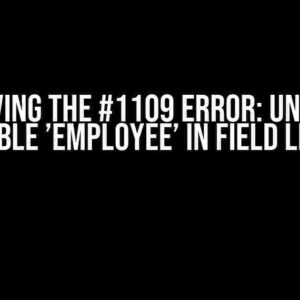Are you frustrated with the “The `pathToDriver` argument hasn’t been specified” error? You’re not alone! This error can be puzzling, especially for those new to Selenium WebDriver. But don’t worry, we’ve got you covered. In this article, we’ll delve into the world of Selenium, explore the root cause of the error, and provide step-by-step instructions to resolve it.
What is Selenium WebDriver?
Selenium WebDriver is a popular open-source tool for automating web browsers. It’s widely used for testing web applications, scraping data, and automating repetitive tasks. WebDriver interacts with browsers using a browser-specific driver, which is responsible for executing commands and retrieving results.
The Importance of `pathToDriver`
In Selenium WebDriver, the `pathToDriver` argument is crucial for specifying the location of the browser-specific driver. This argument tells Selenium where to find the driver executable, allowing it to interact with the browser correctly. Without `pathToDriver`, Selenium can’t initiate the driver, resulting in the “The `pathToDriver` argument hasn’t been specified” error.
Causes of the Error
There are several reasons why you might encounter this error. Let’s explore some common causes:
- Missing or Invalid Driver Path: The most obvious reason is that you haven’t provided a valid `pathToDriver` argument or the path is incorrect.
- Incorrect Driver Version: Using an incompatible driver version with your Selenium version can lead to this error.
- Corrupted Driver Executable: A corrupted driver executable can prevent Selenium from interacting with the browser.
- Browser-Specific Issues: Browser-specific configurations or add-ons can interfere with Selenium’s ability to interact with the browser.
Resolving the Error
Now that we’ve identified the causes, let’s dive into the solutions. Follow these step-by-step instructions to resolve the “The `pathToDriver` argument hasn’t been specified” error:
Step 1: Download the Correct Driver
Visit the official Selenium website (https://www.selenium.dev/downloads/) and download the correct driver for your browser:
- Chrome: chromedriver (https://sites.google.com/chromium.org/driver/)
- Firefox: geckodriver (https://github.com/mozilla/geckodriver/releases)
- Edge: edgedriver (https://developer.microsoft.com/en-us/microsoft-edge/tools/webdriver/)
- Internet Explorer: IEDriverServer (https://www.selenium.dev/downloads/)
Step 2: Set the `pathToDriver` Argument
In your code, specify the correct `pathToDriver` argument when creating a new instance of the WebDriver:
from selenium import webdriver
# Set the path to the driver executable
driver_path = '/path/to/chromedriver'
# Create a new instance of the WebDriver
driver = webdriver.Chrome(executable_path=driver_path)Step 3: Verify Driver Version Compatibility
Ensure that your WebDriver and browser versions are compatible. You can check the Selenium documentation for recommended versions:
| Selenium Version | Browser Version | Driver Version |
|---|---|---|
| 4.x | Chrome 80-83 | ChromeDriver 80.0.3987.106 |
| 3.x | Firefox 75-77 | geckodriver 0.26.0 |
| 4.x | Edge 80-83 | edgedriver 80.0.3987.106 |
| 3.x | Internet Explorer 11 | IEDriverServer 3.150.1 |
Step 4: Check Browser-Specific Configurations
Review your browser-specific configurations and add-ons to ensure they’re not interfering with Selenium:
- Disable any browser extensions that might be conflicting with Selenium.
- Verify that your browser is set to allow automation.
Common Scenarios and Solutions
Let’s explore some common scenarios and solutions to help you troubleshoot the error:
Scenario 1: Missing Driver Executable
If you’ve forgotten to download the driver executable, simply download it and specify the correct `pathToDriver` argument.
Scenario 2: Incorrect Driver Version
If you’re using an incompatible driver version, update to a compatible version or downgrade/upgrade Selenium to match the driver version.
Scenario 3: Corrupted Driver Executable
If the driver executable is corrupted, re-download the driver and try again. If the issue persists, try reinstalling Selenium.
Scenario 4: Browser-Specific Issues
If you suspect a browser-specific issue, try disabling extensions, resetting browser settings, or switching to a different browser.
Conclusion
The “The `pathToDriver` argument hasn’t been specified” error can be frustrating, but by following these steps, you should be able to resolve the issue and get back to automating your web browser with Selenium WebDriver. Remember to:
- Download the correct driver for your browser.
- Specify the correct `pathToDriver` argument.
- Verify driver version compatibility.
- Check browser-specific configurations and add-ons.
By following these best practices, you’ll be well on your way to automating web browsers with confidence. Happy automating!
Frequently Asked Question
Stuck with the “The `pathToDriver` argument hasn’t been specified” error? Don’t worry, we’ve got you covered!
What does the “The `pathToDriver` argument hasn’t been specified” error mean?
This error occurs when you’re trying to create a new WebDriver instance, but you haven’t provided the path to the WebDriver executable file. It’s like trying to start a car without filling up the gas tank – it just won’t move!
How do I fix the “The `pathToDriver` argument hasn’t been specified” error?
Easy peasy! Just provide the correct path to the WebDriver executable file when creating the WebDriver instance. For example, if you’re using ChromeDriver, you can do something like this: `WebDriver driver = new ChromeDriver(“/path/to/chromedriver”);`. Voilà!
Where can I find the WebDriver executable file?
You can download the WebDriver executable file from the official website of the browser you’re using. For example, if you’re using Chrome, you can download the ChromeDriver from the Chromium website. Just make sure you download the correct version that matches your browser version!
Can I use a relative path for the `pathToDriver` argument?
Yes, you can use a relative path for the `pathToDriver` argument, but be careful! The path should be relative to the current working directory of your project, not the project directory itself. For example, if your WebDriver executable file is located in a `drivers` folder in your project directory, you can use `WebDriver driver = new ChromeDriver(“./drivers/chromedriver”);`. Just remember to adjust the path accordingly!
What if I’m using a WebDriver manager like WebDriverManager?
If you’re using a WebDriver manager like WebDriverManager, you don’t need to specify the `pathToDriver` argument at all! The manager will automatically download and configure the WebDriver executable file for you. Just make sure you’ve installed the manager correctly and imported the correct dependencies in your project!



